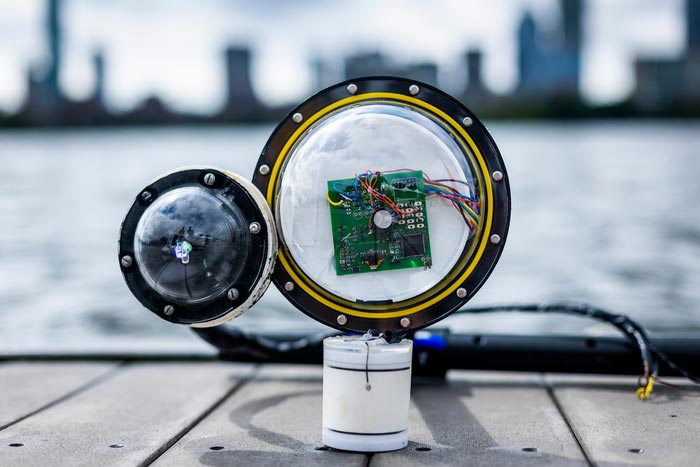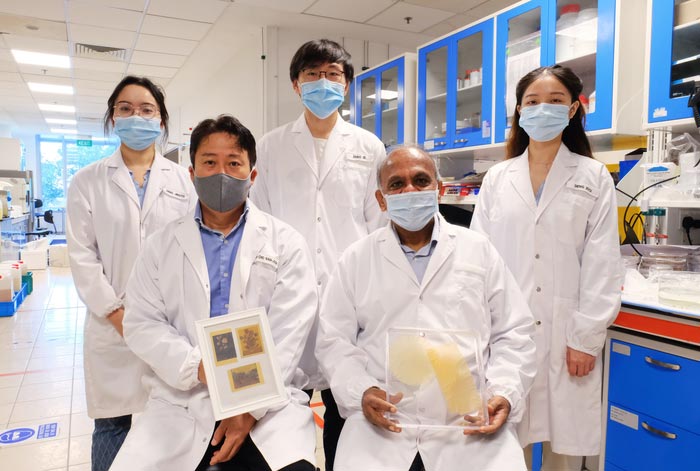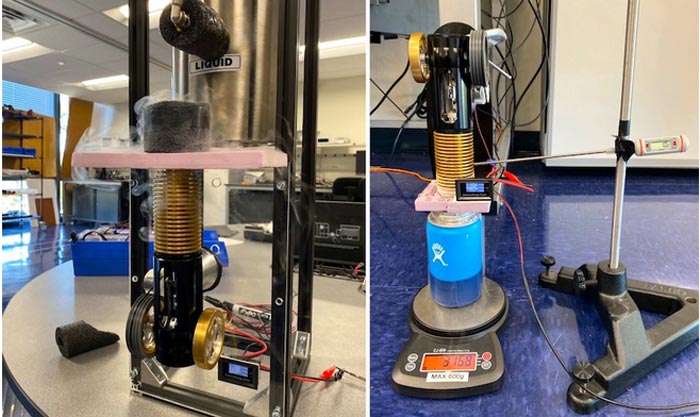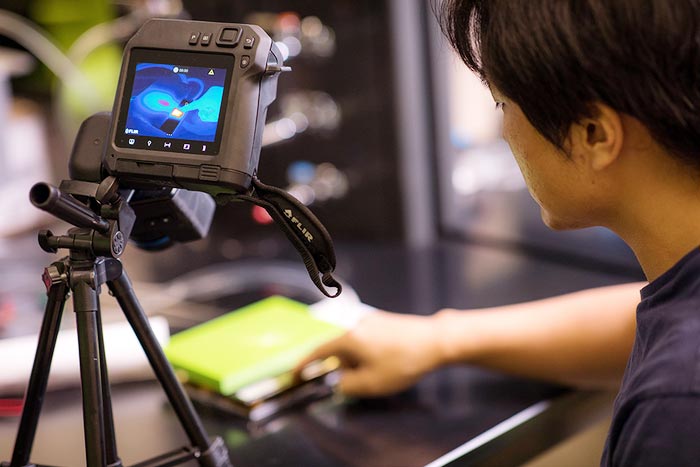
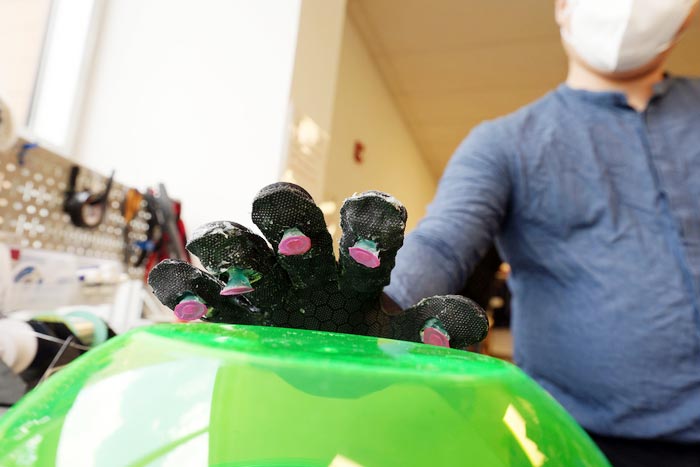
Researchers test the Octa-Glove in the lab of Michael Bartlett.
Photo by Alex Parrish for Virginia Tech
A team of researchers, led by Virginia Tech, has engineered a glove that mimics the arm of an octopus. This work was featured on the cover of Science Advances.
A team of researchers led by Virginia Tech’s Michael Bartlett have developed an octopus-inspired glove capable of securely gripping objects underwater. Their research was selected for the July 13 cover of Science Advances.
Humans aren’t naturally equipped to thrive in an underwater environment. We use tanks to breathe, neoprene suits to protect and warm our bodies, and goggles to see clearly. In such an environment, the human hand also is poorly equipped to hold onto things. Anyone who has tried to hold onto a wriggling fish will testify that underwater objects are difficult to grip with our land-dwelling fingers.
“There are critical times when this becomes a liability,” said Bartlett, an assistant professor in the department of mechanical engineering. “Nature already has some great solutions, so our team looked to the natural world for ideas. The octopus became an obvious choice for inspiration.”
Rescue divers, underwater archaeologists, bridge engineers, and salvage crews all use their hands to extract people and objects from water. Human hands with less capability to hold slippery things must resort to using more force, and an iron grip can sometimes compromise those operations. When a delicate touch is required, it would be helpful to have hands made for water.
Those are the very appendages that Bartlett and his fellow researchers sought to build. His team in the Soft Materials and Structures Lab adapted biological solutions into new technologies made from soft materials and robotics.
Grabbing inspiration from powerful adhesion
The octopus is one of the most unique creatures on the planet, equipped with eight long arms that can take hold of myriad things in an aquatic environment. In a beautiful integration of practical tools and intelligence, these arms are covered with suckers controlled by the sea animal’s muscular and nervous systems.
Each sucker, shaped like the end of a plunger, contributes a powerful snatching ability. After the sucker’s wide outer rim makes a seal with an object, muscles contract and relax the cupped area behind the rim to add and release pressure. When many of the suckers are engaged, it creates a strong adhesive bond that is difficult to escape.
“When we look at the octopus, the adhesive certainly stands out, quickly activating and releasing adhesion on demand,” said Bartlett. “What is just as interesting, though, is that the octopus controls over 2,000 suckers across eight arms by processing information from diverse chemical and mechanical sensors. The octopus is really bringing together adhesion tunability, sensing, and control to manipulate underwater objects.”
Putting the inspiration into action
To design their glove, the researchers focused on re-imagining the suckers: compliant, rubber stalks capped with soft, actuated membranes. The design was created to perform the same function as the sucker of an octopus — activating a reliable attachment to objects with light pressure, ideal for adhering to both flat and curved surfaces.
Having developed the adhesive mechanisms, they also needed a way for the glove to sense objects and trigger the adhesion. For this, they brought in Assistant Professor Eric Markvicka from the University of Nebraska-Lincoln, who added an array of micro-LIDAR optical proximity sensors that detect how close an object is. The suckers and LIDAR were then connected through a microcontroller to pair the object sensing with the sucker engagement, thus mimicking the nervous and muscular systems of an octopus.
Using the sensors to engage the suckers also makes the system adaptable. In a natural environment, an octopus winds its arms around crags in rocks and surfaces, attaching to smooth shells and rough barnacles. The research team also wanted something that felt natural to humans and allowed them to pick things up effortlessly, adapting to different shapes and sizes as an octopus would. Their solution was a glove with synthetic suckers and sensors tightly integrated together, a harmony of wearable systems grabbing many different shapes underwater. They called it Octa-glove.
“By merging soft, responsive adhesive materials with embedded electronics, we can grasp objects without having to squeeze,” said Bartlett. “It makes handling wet or underwater objects much easier and more natural. The electronics can activate and release adhesion quickly. Just move your hand toward an object, and the glove does the work to grasp. It can all be done without the user pressing a single button.”
Putting on the glove
In testing, the researchers tried a few different gripping modes. To manipulate delicate and lightweight objects, they used a single sensor. They found that they could quickly pick up and release flat objects, metal toys, cylinders, the double-curved portion of a spoon, and an ultrasoft hydrogel ball. By reconfiguring the sensor network to utilize all sensors for object detection, they also were able to grip larger objects such as a plate, a box, and a bowl. Flat, cylindrical, convex, and spherical objects consisting of both hard and soft materials were adhered and lifted, even when users did not grab the object by closing their hands.
“These capabilities mimic the advanced manipulation, sensing, and control of cephalopods and provide a platform for synthetic underwater adhesive skins that can reliably manipulate diverse underwater objects,” said postdoctoral researcher Ravi Tutika. “This is certainly a step in the right direction, but there is much for us to learn both about the octopus and how to make integrated adhesives before we reach nature’s full gripping capabilities.”
Looking forward, the researchers envision the glove playing a role in the field of soft robotics for underwater gripping, applications in user-assisted technologies and health care, and in manufacturing for assembling and manipulating wet objects.
This work was performed with Sean Frey, A.B.M. Tahidul Haque, Elizabeth Krotz, Cole Haverkamp, and Chanhong Lee, representing Virginia Tech, Iowa State University, and the University of Nebraska-Lincoln. The research was supported by the National Science Foundation through the Designing Materials to Revolutionize and Engineer our Future program.
Media assets, including video and photo, can be found here.
Journal: Science Advances
DOI: 10.1126/sciadv.abq1905
Method of Research: Experimental study
Subject of Research: Animals
Article Title: Octopus-inspired adhesive skins for intelligent and rapidly switchable underwater adhesion
Article Publication Date: 13-Jul-2022
Media Contacts
Michael Stowe
Virginia Tech
mstowe@vt.edu
Office: 540-392-4218
Jordan Fifer
Virginia Tech
jordanfifer@vt.edu
Office: United States
Cell: 540-529-8196











